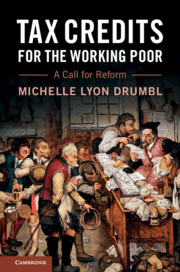Book contents
- Tax Credits for the Working Poor
- Tax Credits for the Working Poor
- Copyright page
- Dedication
- Contents
- Preface and Acknowledgments
- Abbreviations
- Introduction
- 1 A History of the EITC
- 2 Why the United States Uses Lump-Sum Delivery
- 3 How Inexpensive Administration Creates Expensive Challenges
- 4 Importing Ideas
- 5 Reimagining the Credit
- 6 Making a Case for Year-Round EITC Delivery
- 7 Protecting the Antipoverty Element
- 8 Beyond EITC Delivery and Administration
- Index
7 - Protecting the Antipoverty Element
Published online by Cambridge University Press: 24 July 2019
- Tax Credits for the Working Poor
- Tax Credits for the Working Poor
- Copyright page
- Dedication
- Contents
- Preface and Acknowledgments
- Abbreviations
- Introduction
- 1 A History of the EITC
- 2 Why the United States Uses Lump-Sum Delivery
- 3 How Inexpensive Administration Creates Expensive Challenges
- 4 Importing Ideas
- 5 Reimagining the Credit
- 6 Making a Case for Year-Round EITC Delivery
- 7 Protecting the Antipoverty Element
- 8 Beyond EITC Delivery and Administration
- Index
Summary
Chapter 7 identifies a conundrum of the EITC: It is intended to lift low-income individuals out of poverty, yet the credit is subject to capture by a number of creditors and agencies. Because it is delivered as a tax refund, the amount due to the taxpayer can be offset against outstanding federal and state tax liabilities, past-due child support, and federal student loan liabilities. The possibility of such offset betrays its function as an antipoverty supplement. Low-income families are subject to various economic stressors and are likely to have outstanding debts. In reconfiguring the credit into two distinct elements – an incentive to work and an antipoverty supplement – Congress might consider whether the latter should be protected from offset or garnishment (in whole or in part) in order to better serve its purpose. This chapter considers the pros and cons of such a protection, and proposes some possible structures.
- Type
- Chapter
- Information
- Tax Credits for the Working PoorA Call for Reform, pp. 176 - 202Publisher: Cambridge University PressPrint publication year: 2019

